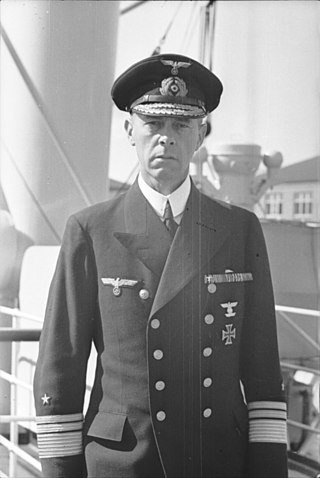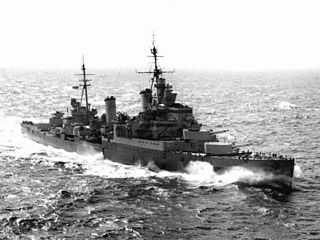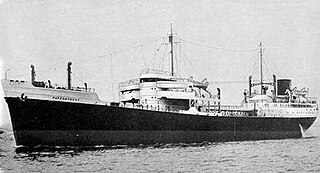Related Research Articles

Operation Rheinübung was the last sortie into the Atlantic by the new German battleship Bismarck and heavy cruiser Prinz Eugen on 18–27 May 1941, during World War II. This operation aimed to block Allied shipping to the United Kingdom as the previously successful Operation Berlin had done. After Bismarck had sunk HMS Hood during the Battle of the Denmark Strait, it culminated with the sinking of the Bismarck, while Prinz Eugen escaped to port in occupied France. From that point on, Germans would rely only on U-boats to wage the Battle of the Atlantic.

HX convoys were transatlantic convoys in the North Atlantic during the First World War and in the Battle of the Atlantic in the Second World War. HX convoys sailed eastwards from Halifax, Nova Scotia in Canada, to Liverpool and other ports in Britain. They were joined the BHX convoys from Bermuda en route. After the United States entered the war, HX convoys began at New York.
HMS Audacity was a British escort carrier of the Second World War and the first of her kind to serve in the Royal Navy. She was originally the German merchant ship Hannover, which the British captured in the West Indies in March 1940 and renamed Sinbad, then Empire Audacity. She was converted and commissioned as HMS Empire Audacity, then as HMS Audacity. She was torpedoed and sunk by a German U-boat in late 1941.

Admiral Hipper was the lead ship of the Admiral Hipper class of heavy cruisers which served with Nazi Germany's Kriegsmarine during World War II. The ship was laid down at the Blohm & Voss shipyard in Hamburg in July 1935 and launched in February 1937; Admiral Hipper entered service shortly before the outbreak of war, in April 1939. The ship was named after Admiral Franz von Hipper, commander of the German battlecruiser squadron during the Battle of Jutland in 1916 and later commander-in-chief of the German High Seas Fleet. She was armed with a main battery of eight 20.3 cm (8 in) guns and, although nominally under the 10,000-long-ton (10,160 t) limit set by the Anglo-German Naval Agreement, actually displaced over 16,000 long tons (16,260 t).

HMS Sheffield was one of the Southampton sub class of the Town-class cruisers of the Royal Navy. Completed in 1937, she was active in all major naval European theatres of the Second World War : in the Atlantic Ocean, the Mediterranean Sea and the Arctic Ocean. Sheffield assisted in the sinking of both German battleships sunk at sea : in the Last battle of Bismarck she directed torpedo aircraft to Bismarck, and during the Battle of the North Cape she took part in the shadowing of Scharnhorst.

Operation Nordseetour was a raid conducted between 30 November and 27 December 1940 by the German heavy cruiser Admiral Hipper. It was part of the Battle of the Atlantic of World War II, with the ship seeking to attack Allied convoys in the North Atlantic. Admiral Hipper left Germany on 30 November 1940 and entered the Atlantic after evading British patrols. She had difficulty locating any convoys and was plagued by engine problems and bad weather. While returning to Brest in German-occupied France, Admiral Hipper encountered Convoy WS 5A on the night of 24 December. A torpedo attack that night did not inflict any damage and Admiral Hipper was driven off by the convoy's escorts when she attacked on the next morning. Two British transports and a heavy cruiser were damaged. The German cruiser sank a merchant ship later on 25 December, and arrived in Brest on 27 December.

Operation Collar was a small, fast three-ship convoy during the Second World War. The convoy left Britain on 12 November 1940 and passed Gibraltar on 24 November, escorted by two cruisers, two ships for Malta and one bound for Alexandria. Numerous other operations took place partly as diversions and the Italian Fleet sailed to attack British ships, leading to the inconclusive Battle of Cape Spartivento on 27 November. The two merchant ships reached Malta on 26 November.
Michel(HSK-9) was an auxiliary cruiser of Nazi Germany's Kriegsmarine that operated as a merchant raider during World War II. Built by Danziger Werft in Danzig 1938/39 as the freighter Bielsko for the Polish Gdynia-America-Line (GAL), she was requisitioned by the Kriegsmarine at the outbreak of World War II and converted into the hospital ship Bonn. In the summer of 1941, she was converted into the auxiliary cruiser Michel, and was commissioned on 7 September 1941. Known as Schiff 28, her Royal Navy designation was Raider H. She was the last operative German raider of World War II.

HMS Durban was a Danae-class light cruiser of the Royal Navy. She was launched from the yards of Scotts Shipbuilding and Engineering Company on 29 May 1919 and commissioned on 1 November 1921.
MV Atheltemplar was a motor tanker built by Lithgows, Port Glasgow. She was launched on 15 April 1930, registered in Liverpool and operated by the United Molasses Co Ltd of London. She was transferred to Athel Lines on 1 January 1940.

Operation MB8 was a British Royal Navy operation in the Mediterranean Sea from 4 to 11 November 1940. It was made up of six forces comprising two aircraft carriers, five battleships, 10 cruisers and 30 destroyers, including much of Force H from Gibraltar, protecting four supply convoys. It consisted of Operation Coat, Operation Crack, Convoy MW 3, Convoy ME 3, Convoy AN 6 and the main element Operation Judgement.

Wahehe was a 4,690 GRT cargo ship which was built in 1922 as Wadigo by Reiherstieg Schiffswerfte und Maschinenfabrik, Hamburg for Woermann Linie AG. She was converted to a refrigerated cargo liner in about 1934.

The German destroyer Z4 Richard Beitzen was one of four Type 1934 destroyers built for the German Navy (Kriegsmarine) during the mid-1930s. Completed in 1937, the ship spent most of her time training although she did participate in the occupation of Memel in early 1939. At the beginning of World War II in September 1939, the ship was initially deployed to blockade the Polish coast, but was soon transferred to the Kattegat where she inspected neutral shipping for contraband goods. In late 1939 and early 1940, the ship laid two offensive minefields off the English coast that claimed 17 merchant ships. Z4 Richard Beitzen was in reserve during the Norwegian Campaign of early 1940 and was transferred to France later that year, where she made several attacks on British shipping.

Z16 Friedrich Eckoldt was a Type 1934A-class destroyer built for Nazi Germany's Kriegsmarine in the late 1930s. It was named after Kapitänleutnant Friedrich Eckoldt (1887–1916), the commander of torpedo boat V 48, who was killed when his boat was sunk during the Battle of Jutland on 31 May 1916.
British Corporal was a 6,972 GRT tanker that was built in 1922 by Palmers Shipbuilding and Iron Company, Jarrow, Northumberland, United Kingdom. She was built for the British Tanker Company.

Empire Endurance was a 8,514 GRT steam cargo liner that was built in 1928 as Alster by Deschimag Werk Vulkan, Hamburg, Germany for the shipping company Norddeutscher Lloyd. In the years leading up to the Second World War Alster carried cargo and passengers between Germany and Australia. After the outbreak of war she was requisitioned by the Kriegsmarine for use as a supply ship.

MV Esso Hamburg was a supply tanker ordered from Deutsche Werft Finkenwerder in 1939 for the Panama Transport Company as MV Esso Colon. Later in 1939 ownership was transferred to the Deutsch-Amerikanische Petroleum company and she was launched as Esso Hamburg on 9 October 1939. She was subsequently used as an oiler for Bismarck and other German warships.

SS Gedania was an oil tanker built in 1919-1920 at Kiel, Germany for the Standard Oil of New Jersey's transatlantic shipments to Germany, and registered under the flag of the Free City of Danzig. In 1940, the tanker was requisitioned by the Kriegsmarine and converted to a support ship for naval operations in the Atlantic. On the first mission in July 1941, to support commerce raiding by the German battleship Bismarck and cruiser Prinz Eugen, Gedania was captured and taken into service with the British Ministry of War Transport as Empire Garden. In 1947 it returned to commercial service as Southern Garden with the South Georgia Company, transporting whale oil from the southern Atlantic, and carrying supplies and personnel to the whaling stations. The tanker was broken up in 1960.
MV Alstertor was a refrigerated cargo ship built in 1938 for Anders Jahres Rederi A/S of Sandefjord, Norway by Oresundsvarvet, Landskrona, Sweden as MV Rose. In 1939 a German ship-owning firm, Rob. M. Sloman, bought her to transport fruit between Santos, Brazil and Hamburg. In 1940 the Kriegsmarine requisitioned her and converted her into a support ship for naval operations in the Atlantic.

Lothringen was an oil tanker ordered for Dutch shipowner Phs. Van Ommeren under the name Papendrecht in Rotterdam. On 16 May 1940, the Kriegsmarine seized her when the ship was still under construction and she was renamed Lothringen. She was commissioned on 23 January 1941. The ship became the property of Erste Deutsche Walfang-Gesellschaft of Hamburg who converted her into a support ship for naval operations by the German battleship Bismarck and cruiser Prinz Eugen in the Atlantic. On 15 June 1941, Lothringen was captured by the British light cruiser HMS Dunedin and taken into service of the Admiralty, crewed by the Royal Fleet Auxiliary. It was renamed Empire Salvage in 1941 and served the Allies for the remainder of the war. After the war, it was handed back to its owners.
References
- ↑ Foundation, Lloyd Register (1 January 1941). Lloyd Register of Shipping 1941 Steamers. London: Lloyd's Register. p. 72.
- ↑ Bassett, Ronald (1988). HMS Sheffield : the life and time of 'Old Shiny'. London: Arms and Armour Press. p. 100. ISBN 0853689113.
- ↑ Paterson, Lawrence (14 April 2022). The U-Boat War: A Global History 1939–45. Bloomsbury Publishing. p. 125. ISBN 978-1-4728-4826-0.
- ↑ Roskill, Stephen Wentworth (1954). "The Defensive". In Butler, J.R.M. (ed.). The War at Sea, 1939-1945: The defensive. Vol. I. H.M. Stationery Office. p. 606.